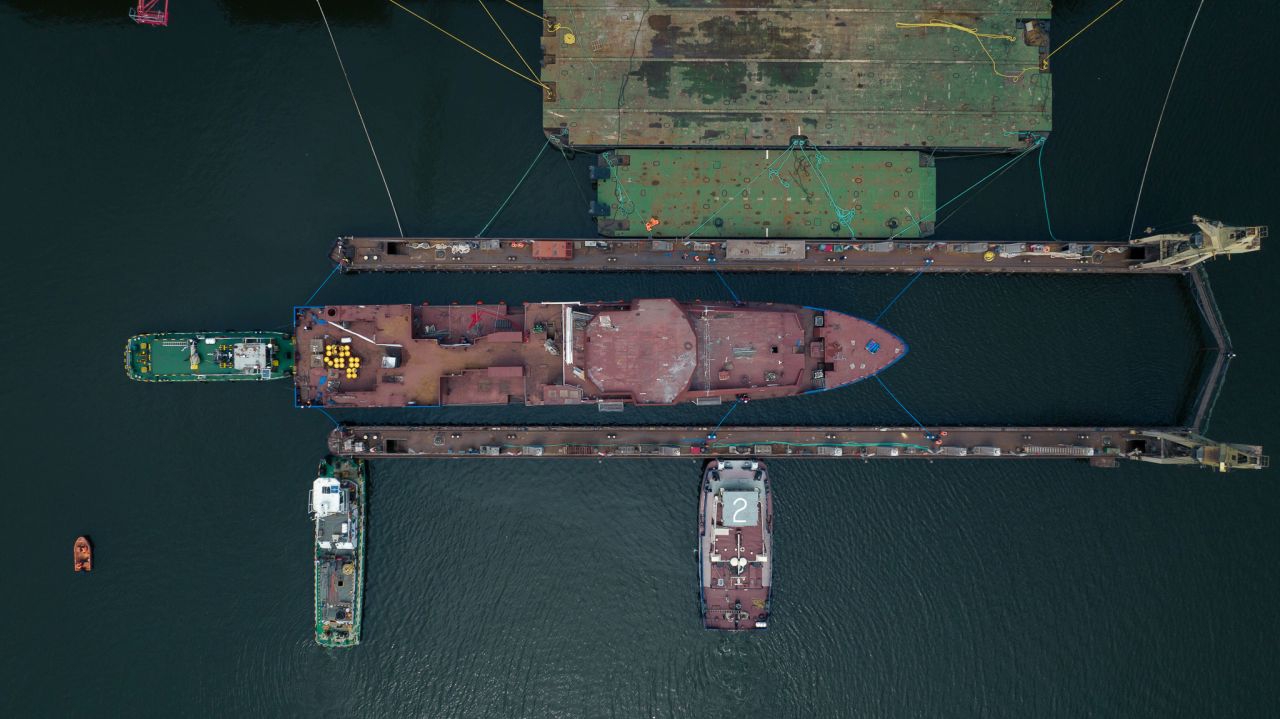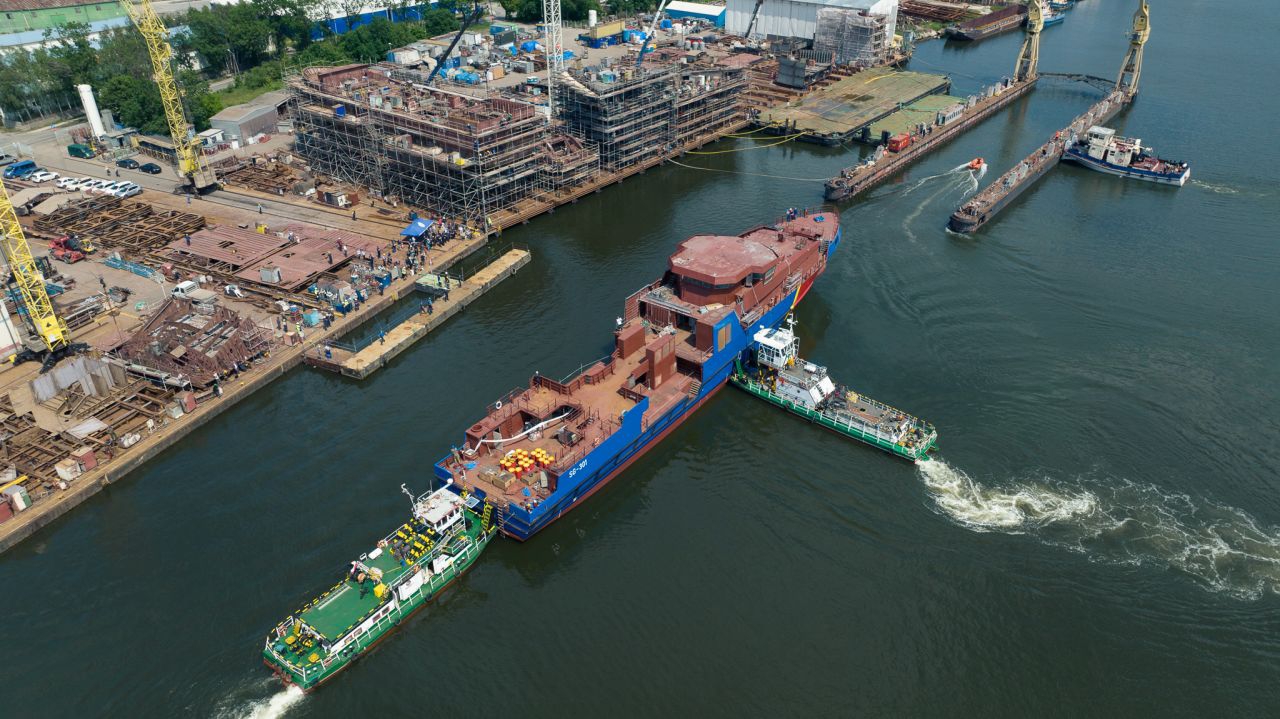![[VIDEO] Hull of patrol vessel for the Polish Border Guard officially launched - MarinePoland.com [VIDEO] Hull of patrol vessel for the Polish Border Guard officially launched - MarinePoland.com](https://www.marinepoland.com/zdjecia/artykul/1582/6450/1200x0/2/sg.jpg)
Work on a
multipurpose seagoing patrol vessel for the Maritime Division of the
Border Guard is at the halfway point. The partially equipped hull
built by NavireTech has just been launched.
Commissioned by the French shipyard Socarenam, which won the tender to build the patrol vessel, the hull was built in Poland by NavireTech shipyard. Construction of the nearly 70-meter vessel began last year. Sheet cutting was done at the Crist shipyard in Gdynia, and the keel was laid in June 2021 at the Marine Stal wharf. After a year of work, the hull, along with the superstructure and partial equipment, was launched - first it was moved from the quay to the floating dock, and after the dock was submerged, the vessel was towed from it and moored at the Marine Projects shipyard quay. The hull will soon be towed to a shipyard in Calais, France, where it will be fitted out. According to the schedule, the Marine Unit of the Border Guard will take over the vessel in 2023.
For NavireTech, building the
entire, partially equipped hull of the patrol vessel in Poland was a
new challenge. As Artur Nastkiewicz, the company's managing director,
explains, the company has experience in building these types of
structures, but usually does so under different conditions.
- My company has built several
hulls for Socarenam shipyard, among other patrol vessels. But this is
done in France, in a shipyard that is dedicated to this purpose. Here
we were put to the task of building this hull in Poland. We were not
prepared for this, as we do not have a shipyard in Poland in the
sense that we have docks, wharves, production halls. We are adapted
to cooperate with Socarenam by producing sections, which we transport
to France and there we conduct the assembly under their conditions.
Here we were put in a position where we had to deal with construction
on site. So we had to arrange this shipyard - explains Nastkiewicz.
The NavireTech director adds that
the so-called "strong hull", i.e. the steel structure of
the ship itself, was already ready since March. However, it was
decided that some of the outfitting work would be done on site.
- We could have passed this hull as
early as March. On March 30, we completed the construction of the
so-called "strong hull" and it could have been towed away
by then. But this outfitting work, which took place from March until
today, makes it possible to carry out further outfitting in France
more quickly - Nastkiewicz explained.

As the NavireTech director
emphasized, for this reason the official launching of the vessel was
symbolic. The hull had already undergone immersion tests. On June 29,
however, it was towed from the dock at the Marine Projects shipyard
in the presence of guests and media. The ceremony was attended by
representatives not only of the future shipowner, the Border Guard,
but also of many Polish companies involved in the construction, as
well as a guest from France - Philippe Gobert, president of the
Socarenam shipyard.
- This is a very important moment in the life of the Marine Unit of the Border Guard, as this is the first such large vessel to be launched - said Lieutenant Commander SG Andrzej Juźwiak, spokesman for the Commander of the Marine Unit of the Border Guard in Gdansk. - The main tasks that the patrol vessel will face are, of course, service in the protection of the external maritime borders of Poland and the European Union. This will take place mainly in the Baltic Sea and the Mediterranean Sea. But it also needs to be clearly emphasized that this is a patrol vessel intended for participation in multi-purpose international maritime operations coordinated by the European Border and Coast Guard Agency Frontex - explains Juźwiak.

SG-301 will have a diesel-electric
propulsion system with azimuthal thrusters that will allow it to
develop speeds of up to 19 knots. A thruster will be installed on the
bow, which will increase the ship's maneuvering properties. Of
course, the vessel will operate an exhaust gas treatment system, a
sewage and bilge water treatment system and a system for generating
fresh water from the sea.
The ship is being built in the "design
and build" mode. The value of the contract is about 111 million
zlotys, of which up to 90 percent comes from the European Union's
Internal Security Fund, and the rest is covered by the state budget.
- Above all, I feel joy that such
an important part of this project has been finalized, as we are at
the halfway point of the construction of a patrol vessel for the
Marine Unit of the Border Guard. What remains is to wish all the
officers who will sail on this vessel that this service will be safe
and comfortable - enthuses Lieutenant Commander SG Andrzej Juźwiak.
Artur Nastkiewicz of NavireTech
says that the construction of the partially equipped hull of the
patrol vessel for the Border Guard shows that the company is
competent to carry out such orders.
- We have shown that we have the
cadres to do it - specialists, welders, fitters, pipefitters, people
for reinforcement, for aluminum structures, as well as a design
bureau that cooperates with us constantly. We also have supervisory
cadres. The company is certified by Bureau Veritas, PRS, the 1090
standard, which allows the construction of steel structures,
including for offshore - says Nastkiewicz.


